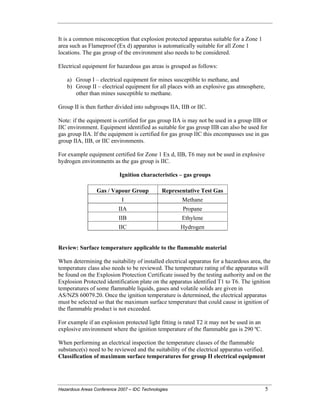The Best Guide To Roar Solutions
Wiki Article
The Ultimate Guide To Roar Solutions
Table of ContentsThe 2-Minute Rule for Roar SolutionsNot known Facts About Roar SolutionsAn Unbiased View of Roar Solutions
In order to secure setups from a prospective explosion an approach of evaluating and identifying a possibly hazardous location is needed. The purpose of this is to guarantee the correct choice and installation of equipment to eventually stop a surge and to make certain safety and security of life.
(https://urlscan.io/result/8b06a2f1-9edb-4076-8512-31003b1bcc3a/)
No devices should be installed where the surface area temperature of the tools is higher than the ignition temperature level of the provided risk. Below are some usual dust dangerous and their minimal ignition temperature. Coal Dirt 380C 225C Polythene 420C (melts) Methyl Cellulose 420C 320C Starch 460C 435C Flour 490C 340C Sugar 490C 460C Grain Dirt 510C 300C Phenolic Material 530C > 450C Aluminium 590C > 450C PVC 700C > 450C Soot 810C 570C The probability of the danger existing in a focus high adequate to create an ignition will vary from place to location.
Unsafe location electric tools possibly created for use in greater ambient temperatures. Area Fixing By Authorised Employee: Complicated testing may not be called for however specific procedures may need to be followed in order for the equipment to maintain its 3rd event ranking. Each item of tools with an unsafe score must be evaluated separately.
Excitement About Roar Solutions
The devices register is an extensive data source of equipment documents that consists of a minimum set of fields to determine each product's location, technological criteria, Ex category, age, and ecological information. This details is critical for monitoring and handling the devices successfully within unsafe areas. On the other hand, for routine or RBI tasting examinations, the grade will certainly be a combination of Thorough and Close assessments. The ratio of Detailed to Close examinations will be established by the Tools Risk, which is examined based on ignition risk (the likelihood of a source of ignition versus the likelihood of a combustible atmosphere )and the harmful location classification( Area 0, 1, or 2). This variant will certainly additionally influence the resourcing requirements for work preparation. Once Lots are specified, you can develop sampling plans based upon the example size of each Great deal, which describes the number of arbitrary equipment items to be checked. To establish the needed example size, 2 elements need to be evaluated: the dimension of the Lot and the category of evaluation, which suggests the level of effort that ought to be used( minimized, normal, or increased )to the inspection of the Lot. By integrating the classification of examination with the Whole lot dimension, you can then establish the proper denial requirements for an example, indicating the allowed number of faulty things discovered within that sample. For even more details on this process, please describe the Power Institute Standards. The IEC 60079 standard advises that the maximum interval in between inspections must not surpass 3 years. EEHA assessments will additionally be carried out beyond RBI campaigns as part of arranged upkeep and equipment overhauls or repair work. These examinations can be attributed toward the RBI example sizes within the affected Lots. EEHA assessments are conducted to determine mistakes in electrical devices. A weighted racking up system is crucial, as a solitary item Click Here of equipment might have multiple faults, each with differing levels of ignition danger. If the mixed rating of both evaluations is less than twice the fault score, the Whole lot is considered acceptable. If the Whole lot is still thought about undesirable, it must go through a full evaluation or reason, which may set off stricter assessment protocols. Accepted Lot: The reasons for any kind of faults are determined. If an usual failure mode is found, added devices might require maintenance. Faults are categorized by extent( Safety, Stability, Home cleaning ), making sure that urgent issues are evaluated and dealt with without delay to mitigate any kind of influence on safety and security or operations. The EEHA data source must track and tape the lifecycle of mistakes together with the rehabilitative actions taken. Executing a durable Risk-Based Inspection( RBI )technique is crucial for guaranteeing compliance and safety and security in handling Electrical Devices in Hazardous Locations( EEHA) (Roar Training Solutions). Automated Fault Scoring and Lifecycle Administration: Easily handle mistakes and track their lifecycle to improve assessment accuracy. The introduction of this assistance for risk-based evaluation better enhances Inspectivity's placement as a best-in-class remedy for regulatory compliance, along with for any type of asset-centric examination usage situation. If you are interested in finding out more, we invite you to ask for a demonstration and uncover just how our service can change your EEHA management processes.
Some Known Details About Roar Solutions

In terms of eruptive danger, a harmful location is a setting in which an explosive atmosphere is present (or might be expected to be existing) in amounts that need unique precautions for the building, installation and use tools. electrical refresher course. In this short article we check out the obstacles dealt with in the work environment, the threat control procedures, and the required proficiencies to work securely
It issues of modern-day life that we make, store or deal with a series of gases or fluids that are regarded combustible, and a series of dusts that are considered flammable. These materials can, in particular problems, create explosive environments and these can have major and tragic effects. The majority of us recognize with the fire triangular get rid of any type of among the 3 aspects and the fire can not occur, yet what does this mean in the context of hazardous locations? When damaging this down right into its most basic terms it is basically: a combination of a particular quantity of release or leak of a certain substance or material, combining with ambient oxygen, and the existence of a resource of ignition.
In many instances, we can do little about the degrees of oxygen airborne, yet we can have significant impact on resources of ignition, for instance electrical tools. Dangerous locations are recorded on the unsafe area classification drawing and are determined on-site by the triangular "EX-SPOUSE" indication. Right here, amongst other essential information, areas are divided right into three types relying on the risk, the possibility and period that an explosive environment will certainly exist; Area 0 or 20 is regarded the most dangerous and Area 2 or 22 is considered the least.
Report this wiki page